The Difference between Hubs and Switches
Ethernet hubs and switches are both used for networking workstations, file servers, printers, and many other components (each of which is referred to as a 'node' of the network). The main difference between hubs and switches is the way in which the nodes communicate with the network. There are advantages and disadvantages to both, and which one you use will depend on the size of your network, the amount of traffic that it handles, and its purpose.
Ethernet Hubs
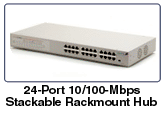 Hubs form the heart of a network, with every separate node of the network connected to the hub through its ports. Anything from a file server to a workstation to a print server can be connected to the hub, making it accessible to every other node of the network. Hubs form the heart of a network, with every separate node of the network connected to the hub through its ports. Anything from a file server to a workstation to a print server can be connected to the hub, making it accessible to every other node of the network.
There are three main points to remember about hubs:
- Many kinds of nodes can be connected to the hub with networking cable.
- All hubs can be uplinked together, either with stright-through cable or cross-over cable, depending on whether or not the hub has an uplink port.
- Performance will decrease as the number of users is increased.
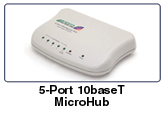 When choosing a hub, the main consideration should be performance. If the hub is 100Mbps and there are five users, each user will receive only 20Mbps of bandwidth. If the hub is intended for a small network with very little traffic, this should not be a problem. However, if the network is large or expected to expand, a switch is a better option in the end. When choosing a hub, the main consideration should be performance. If the hub is 100Mbps and there are five users, each user will receive only 20Mbps of bandwidth. If the hub is intended for a small network with very little traffic, this should not be a problem. However, if the network is large or expected to expand, a switch is a better option in the end.
When considering a hub, always remember that the network may expand in the future. Try to buy a hub that has enough ports to allow expansion without more hardware purchases. If expansion is not an immediate concern, remember that in the future you can add more hubs.
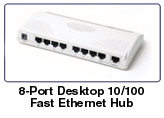 The standard hub is great for starting a small network, or providing a network to one department. There are two basic types: 10baseT, which will support a speed of 10Mbps; and 100baseTX, which supports 100Mbps. A standard 10baseT hub cannot connect to hardware that runs at 100Mbps unless a switch or hub with auto-sensing capabilities is used between them. If your network is small and will not require expansion in the near future, a standard hub is the perfect solution. The standard hub is great for starting a small network, or providing a network to one department. There are two basic types: 10baseT, which will support a speed of 10Mbps; and 100baseTX, which supports 100Mbps. A standard 10baseT hub cannot connect to hardware that runs at 100Mbps unless a switch or hub with auto-sensing capabilities is used between them. If your network is small and will not require expansion in the near future, a standard hub is the perfect solution.
Many hubs have one or more of the following extra features, which can increase ease of use, efficiency, and expandability:
- Auto-sensing or dual-speed 10/100Mbps. Hubs with this feature can support hardware running at both speeds, increasing the length of time you can use your old 10baseT hardware.
- Stackable hubs. Hubs with this feature are very expandable, operating as a single hub when stacked together. While standard hubs can only be uplinked through four hubs, a stacked hub is considered a single hub and there is no uplinking required.
- SNMP (Simple Network Management Protocol). Hubs that support SNMP allow configuration of the hub from anywhere on the network. This feature can be extremely useful in LANs that span two or more floors, or have more than 50 users.
Final note on hubs: Always remember that hubs can only communicate in half duplex mode, which means that a computer on the network can only send data when it is not receiving. If the network requires full duplex mode, use a switch rather than a hub.
Ethernet Switches
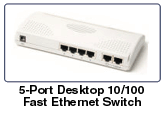 Switches have many features that make them different than hubs. The most compelling reason to choose a switch rather than a hub is bandwidth. When a 100Mbps hub has five workstations, each receives 20Mbps of bandwidth. When a 10/100Mbps switch is used, each workstation receives 100Mbps of bandwidth, dramatically increasing the speed of the connection. Switches also run in full duplex mode, which allows data to be sent and received across the network at the same time. Switches effectively double the speed of the network when compared to hubs, which only support half duplex mode. Switches have many features that make them different than hubs. The most compelling reason to choose a switch rather than a hub is bandwidth. When a 100Mbps hub has five workstations, each receives 20Mbps of bandwidth. When a 10/100Mbps switch is used, each workstation receives 100Mbps of bandwidth, dramatically increasing the speed of the connection. Switches also run in full duplex mode, which allows data to be sent and received across the network at the same time. Switches effectively double the speed of the network when compared to hubs, which only support half duplex mode.
A 10/100Mbps switch can also support hardware running at either 10Mbps or 100Mbps, allowing the continued use of older technology and delaying replacement.
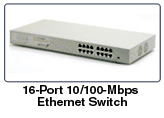 Switches will increase the speed and efficiency of networks in any of the following situations: Switches will increase the speed and efficiency of networks in any of the following situations:
- Any network that calls for a 10/100 hub will benefit from a 10/100Mbps switch. The switch will increase available bandwidth, drastically increasing the speed that the network is running at.
- Any network that requires enhanced performance for file servers, workstations, Web servers, etc. Any critical components should be connected directly to a 10/100Mbps switch.
- Any network that uses high-speed applications including multimedia and video. Any workstation or file server using the intensive applications should be connected directly to a 10/100Mbps switch.
- Any network and uses Fiber optic cabling should use a 10/100Mbps switch rather than a hub. A hub will not take full advantage of the speed possible with Fiber optic cabling.
Summary
The main difference between hubs and switches is the bandwidth available to network users.

If your network consists of very few nodes, a hub may be the best way to go. However, always keep in mind future expansion of the network. If bandwidth could become an issue among the users of the network, using a switch will increase the efficiency of the network.
Remember that you do not necessarily have to choose between hubs and switches. Your network may benefit most from a combination of the two, with critical components directly connected to the switch, and non-critical components on a hub connected to the switch.
|